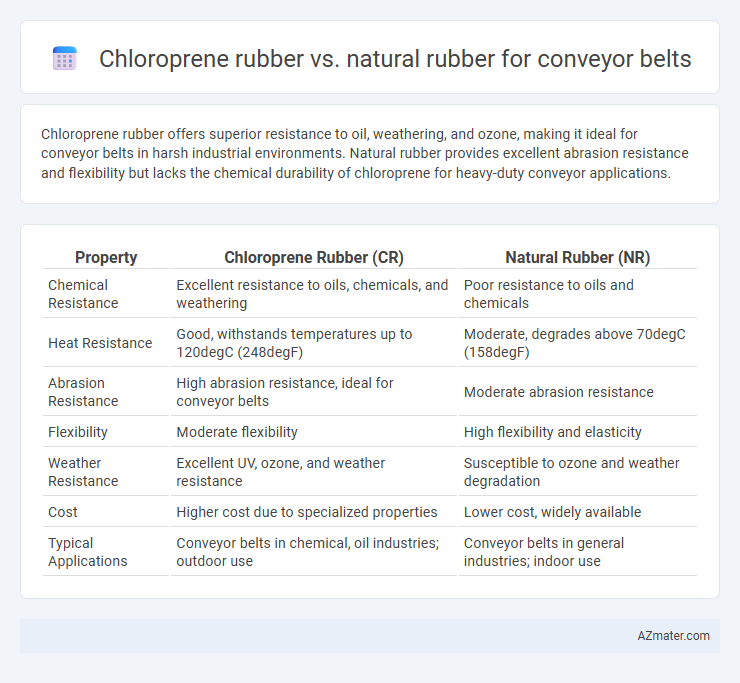Chloroprene rubber offers superior resistance to oil, weathering, and ozone, making it ideal for conveyor belts in harsh industrial environments. Natural rubber provides excellent abrasion resistance and flexibility but lacks the chemical durability of chloroprene for heavy-duty conveyor applications.
Table of Comparison
| Property | Chloroprene Rubber (CR) | Natural Rubber (NR) |
|---|---|---|
| Chemical Resistance | Excellent resistance to oils, chemicals, and weathering | Poor resistance to oils and chemicals |
| Heat Resistance | Good, withstands temperatures up to 120degC (248degF) | Moderate, degrades above 70degC (158degF) |
| Abrasion Resistance | High abrasion resistance, ideal for conveyor belts | Moderate abrasion resistance |
| Flexibility | Moderate flexibility | High flexibility and elasticity |
| Weather Resistance | Excellent UV, ozone, and weather resistance | Susceptible to ozone and weather degradation |
| Cost | Higher cost due to specialized properties | Lower cost, widely available |
| Typical Applications | Conveyor belts in chemical, oil industries; outdoor use | Conveyor belts in general industries; indoor use |
Introduction to Conveyor Belt Materials
Chloroprene rubber (CR) and natural rubber (NR) are key materials used in conveyor belt manufacturing due to their distinct properties. Chloroprene rubber offers excellent resistance to oils, chemicals, and weathering, making it suitable for harsh industrial environments. Natural rubber provides superior tensile strength, abrasion resistance, and flexibility, enhancing durability under heavy loads and impact conditions.
Overview of Chloroprene Rubber
Chloroprene rubber (CR), also known as Neoprene, offers exceptional resistance to oils, chemicals, and weathering, making it a superior choice for conveyor belts used in harsh industrial environments. Its excellent abrasion resistance, combined with good mechanical strength and flexibility, ensures durability and long service life compared to natural rubber. Chloroprene rubber's enhanced heat resistance and aging stability provide consistent performance in applications requiring prolonged exposure to varying temperatures and mechanical stress.
Properties of Natural Rubber
Natural rubber offers excellent abrasion resistance, high tensile strength, and superior elasticity, making it ideal for conveyor belts subjected to heavy loads and impact stress. Its natural resilience provides excellent grip and flexibility, which enhances belt performance in varying temperature conditions. However, natural rubber can degrade under oil exposure and harsh chemicals, limiting its use in some industrial environments compared to chloroprene rubber.
Key Differences Between Chloroprene and Natural Rubber
Chloroprene rubber exhibits superior resistance to oils, chemicals, and weathering compared to natural rubber, making it ideal for conveyor belts operating in harsh industrial environments. Natural rubber offers excellent tensile strength and elasticity but degrades faster under exposure to ozone, heat, and petroleum-based substances. Key differences include chloroprene's enhanced durability and chemical resistance, whereas natural rubber provides better abrasion resistance and flexibility in moderate conditions.
Abrasion and Wear Resistance Comparison
Chloroprene rubber exhibits superior abrasion and wear resistance compared to natural rubber, making it more durable for conveyor belt applications in harsh environments. Its molecular structure provides enhanced resilience against mechanical stress, abrasion, and chemical exposure, which significantly extends belt lifespan. In contrast, natural rubber offers good elasticity but tends to wear faster and degrade more quickly under abrasive conditions.
Chemical and Weather Resistance
Chloroprene rubber (CR) offers superior chemical resistance compared to natural rubber (NR), effectively withstanding exposure to oils, acids, and ozone, making it ideal for conveyor belts in harsh industrial environments. Its excellent weather resistance, including resistance to UV radiation and oxidation, ensures long-lasting performance in outdoor applications. Natural rubber, while flexible and strong, is more susceptible to degradation from chemicals and weather elements, limiting its use in chemically aggressive or outdoor conditions.
Cost and Availability
Chloroprene rubber offers moderate cost with good durability, but natural rubber is generally more affordable and widely available for conveyor belt applications. Natural rubber's abundant supply ensures lower procurement expenses and easier sourcing in most regions. Although chloroprene rubber provides enhanced chemical resistance, its higher price and limited availability can impact overall project budgets.
Performance in Industrial Applications
Chloroprene rubber offers superior chemical resistance, ozone resistance, and aging stability compared to natural rubber, making it ideal for conveyor belts in harsh industrial environments. Natural rubber provides excellent abrasion resistance and elasticity, but it degrades faster when exposed to oils, solvents, and extreme weather conditions. For conveyor belts handling heavy loads and corrosive materials, chloroprene rubber ensures longer service life and reduced maintenance costs.
Environmental Impact and Sustainability
Chloroprene rubber offers superior chemical resistance and durability for conveyor belts but presents greater environmental concerns due to its synthetic production and reliance on non-renewable petrochemicals. Natural rubber, harvested from rubber trees, is more sustainable and biodegradable, reducing environmental impact through renewable sourcing and lower carbon emissions during production. However, natural rubber's susceptibility to wear and degradation may necessitate more frequent replacements, influencing the overall lifecycle environmental footprint.
Choosing the Right Rubber for Conveyor Belts
Chloroprene rubber offers superior resistance to oil, weathering, and ozone, making it ideal for conveyor belts operating in harsh industrial environments. Natural rubber provides excellent abrasion resistance and flexibility but lacks the chemical and environmental durability of chloroprene. Selecting chloroprene rubber ensures longer belt life and reduced maintenance in aggressive conditions, while natural rubber suits general-purpose conveyor applications with moderate wear.

Infographic: Chloroprene rubber vs Natural rubber for Conveyor belt
 azmater.com
azmater.com